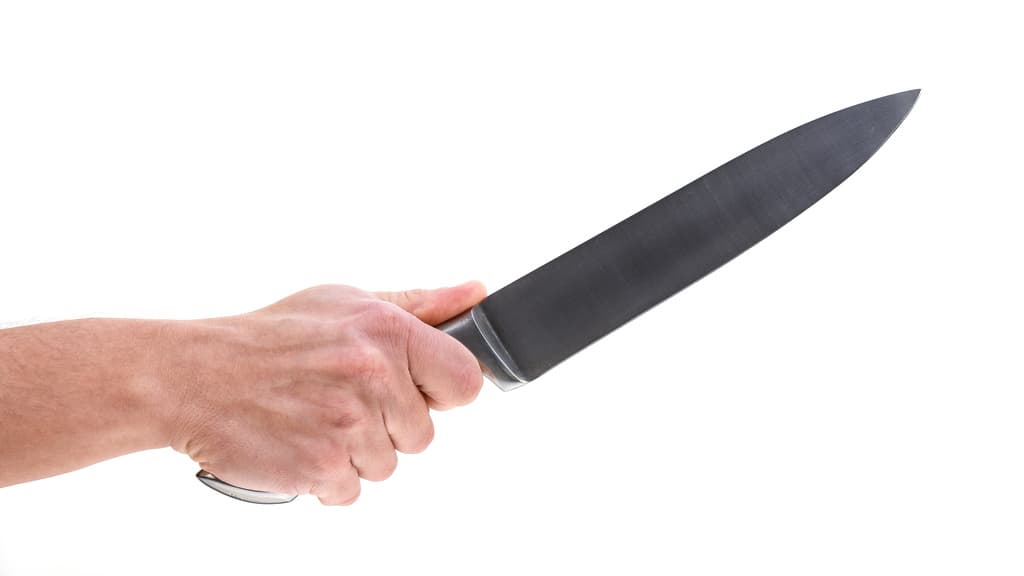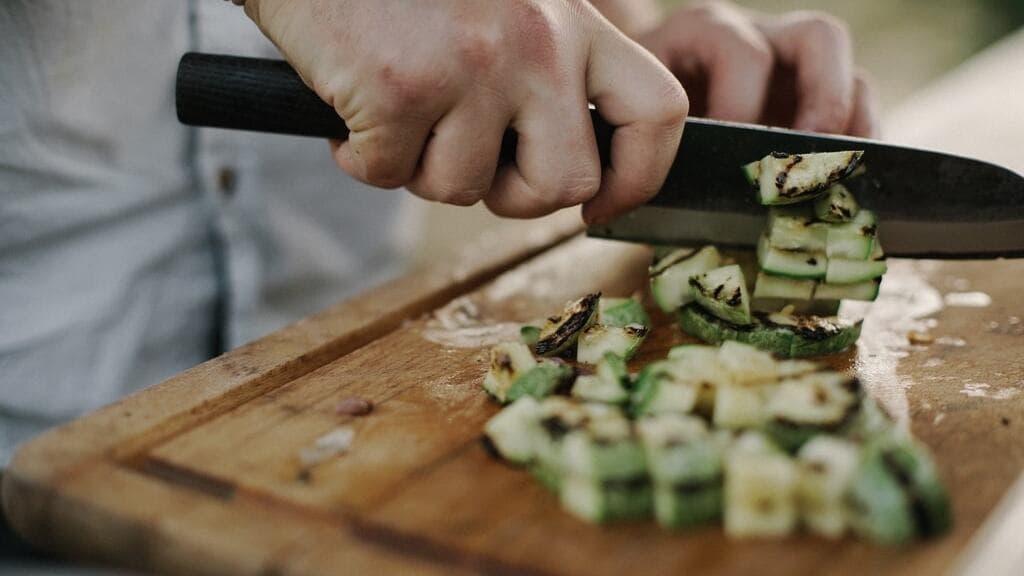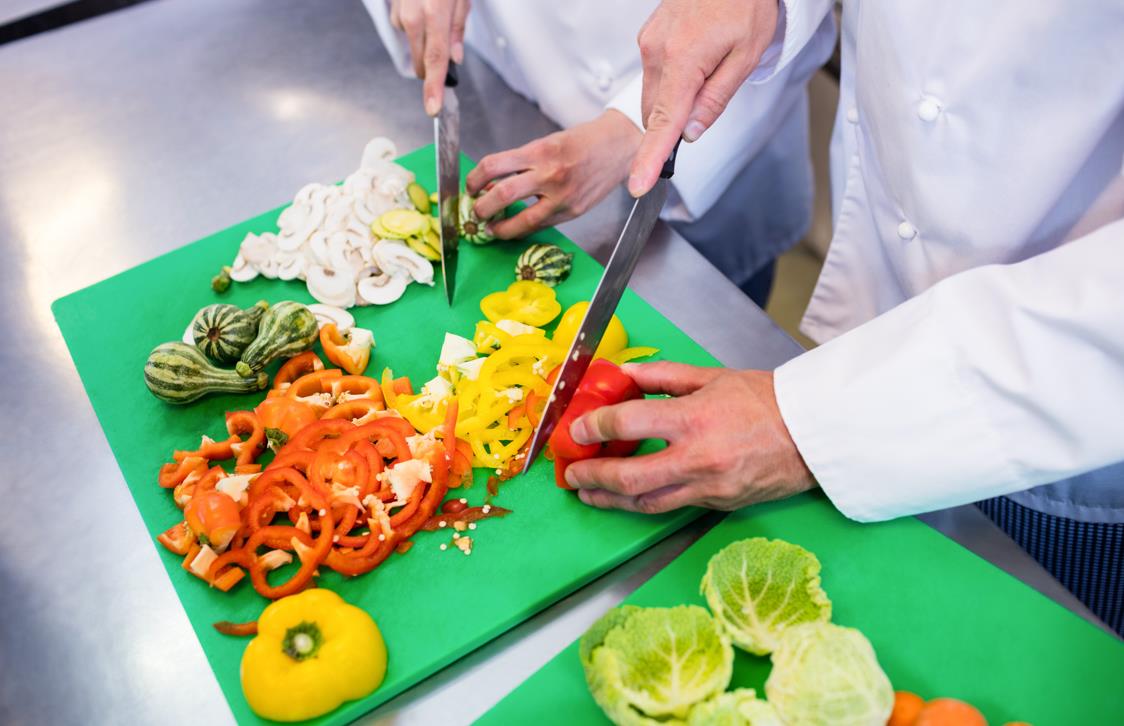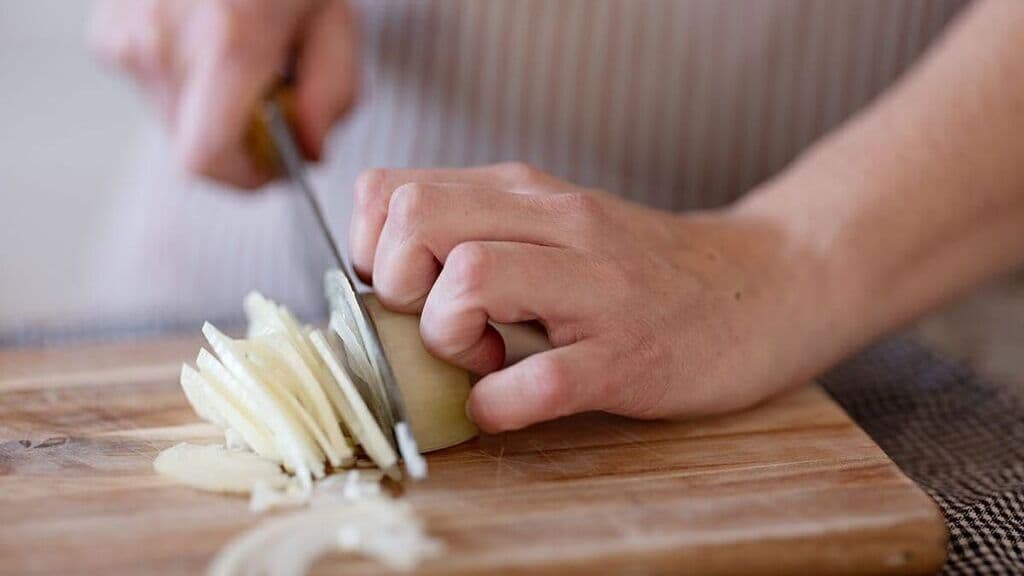Getting a lovely chef’s knife is only the first step, it starts with handling it properly.
Learn how to hold a knife the right way. Whether creating restaurant-quality meals is a hobby or it’s a job you’re anticipating to brace, knowing how to handle a knife to slice and dice ingredients correctly help making dishes look and taste better.
Holding a knife the right way is vital. After all, your knife is a razor-sharp weapon. Operating it incorrectly can lead to accidents. The right way to hold a knife changes with the type of knife, blade, and handle you have in hand, along with the task you’re performing.
This article will explain how to hold a kitchen knife and explain different grips and techniques while answering commonly asked questions.
Table of contents
Handle grip

One of the basic ways to hold a knife, the handle grip, is the easiest to get into and most suited for beginner cooks. In a handle grip, your hands are behind the bolster and fingers tucked on the handle. Your thumb can be an exception to this, which can rest on the blade but is optional. Hold the knife the way you’re comfortable the most.
How to grip a kitchen knife?
- Grab the handle in a comfortable position with your hand right behind the bolster. If the knife doesn’t have a bolster, mark where the blade meets the handle and position your hand accordingly.
- Don’t hold the handle too far back, to the point where you can see the handle. Your hand should be close to the blade but not on it.
Handle grip advantages
- Comfortable
- Perfect for beginners
Handle grip disadvantages
- Offers less control
- Difficult to make precision cuts
Blade grip

The second most fundamental way to hold a knife is the blade grip, also known as the pinch grip. It’s the preferred way of holding a knife by more experienced cooks. The blade grip offers more flexibility and control over the knife than the handle grip.
The thumb and index finger are in front of the bolster in blade grip, sort of pinching it, hence the name. The rest of the fingers are firmly holding the handle. The blade grip offers a higher range of control and balance. The more you practice this grip, the easier it becomes to chop, slice, and mince through ingredients.
How to blade grip a kitchen knife?
- Pinch the blade using your thumb and index finger.
- Wrap the rest of your fingers around the handle.
- Make sure that you’re holding the knife’s handle tight in a comfortable position with your thumb and index finger not going under the cutting edge.
Handpicked for you
True cutting power in the palm of your hand
Blade grip advantages
- Easier precision cuts
- Better control
Blade grip disadvantages
- It can be intimidating for beginners
- Not ideal for tasks requiring a lot of power
- It’s not practical with slim blades, like boning knives
Point grip

Additionally, there is the point grip. In this way of holding a chef’s knife, your index finger is resting on the blade’s spine. This gives the ultimate control to create precision cuts. This grip technique is mainly for precision cuts requiring the highest stability and almost acts as an arm extension. It’s one of the best ways to hold a knife to create fine slices, especially if making non-linear cuts, but it requires more time and practice to master.
How to point grip a kitchen knife?
- Hold the knife similar to the handle grip and extend your index finger over the blade’s spine.
- Your thumb should be closer to the blade, almost or slightly touching it. As you move your index finger on the spine, you’ll feel that it’s easier to control the knife with your thumb a little bit forward.
Point grip advantages
- Offers the highest control and accuracy
- Allows better control of the knife’s tip
Point grip disadvantages
- Intimidating for beginners
- Suitable for certain tasks
Note: some say it’s wrong to put the index finger on the spine when cutting, but there are exceptions to keep in mind. The point grip is generally used by Japanese chefs. As Japanese knives like gyuto can have a different handle that’s straight, the point grip with the index finger on the spine is a comfortable and safe way to handle a knife. Also, the kind of work you’re doing with the knife matters considering different tasks requires changes in the grips.
How to position the other hand? – Guiding hand
It’s essential to know how to hold a kitchen knife properly, but what about the other hand? In other words, your guiding hand.
Claw motion

The claw motion should be mastered by every cook. Although this isn’t a way of holding a knife, it’s an easy yet efficient way to hold the ingredients while cutting. Here is how to properly use the claw technique.
- Form a claw shape with your middle or index finger in the forefront, whichever you’re most comfortable with.
- With your guiding arm turned out, guide the blade and glide along the clawed finger while maintaining the same angle.
- Cut the food by rocking the knife from tip to heel or in up and down motions for faster cuts.
When trying the claw technique for the first time, go slow and pick up the pace as you feel more comfortable. Make sure your hand is relaxed but pay attention to maintaining the claw shape and the angle while cutting.
Tips on handling kitchen knives safely
Now that you know how to hold a knife, here are a few tips to protect yourself from accidents.
Keeping your chef’s knife sharp
A knife that cuts through ingredients like butter is always safer than a not-so-sharp knife. When the blade isn’t sharp enough, it won’t cut right. When cutting an ingredient that requires force, the edge may slip and cut your finger in the process. The sharper the edge, the easier cuts become, and the better you’re going to implement the cutting techniques mentioned above.
Using the right knife for the task
A chef’s knife is a general-purpose tool to handle most of your needs, but it may not suit all tasks. For example, if you’re trying to cut through bones, make sure that you’re using the right kind of knife, like the Serbian chef’s knife we have in our store.
Other tips to help you stay safe
Aside from the two essential tips above, here are a few general tips to avoid accidents.
- Cut the ingredients on a stable board
- Keep the necessary distance between you and the knife
- Don’t try to catch a knife if it slips out of your hands or falls
- Keep your eyes on the blade at all times
- Utilize appropriate storage methods for your kitchen
Commonly asked questions about holding a knife
Now that you learned how to hold a knife properly, you can put them to test. Holding a knife the correct way will help you save time and make those delicious recipes come to life. If you’re unsure about the type of knife you’re going to use, take a look at our handmade kitchen knives to find the one that accommodates your needs the most.












